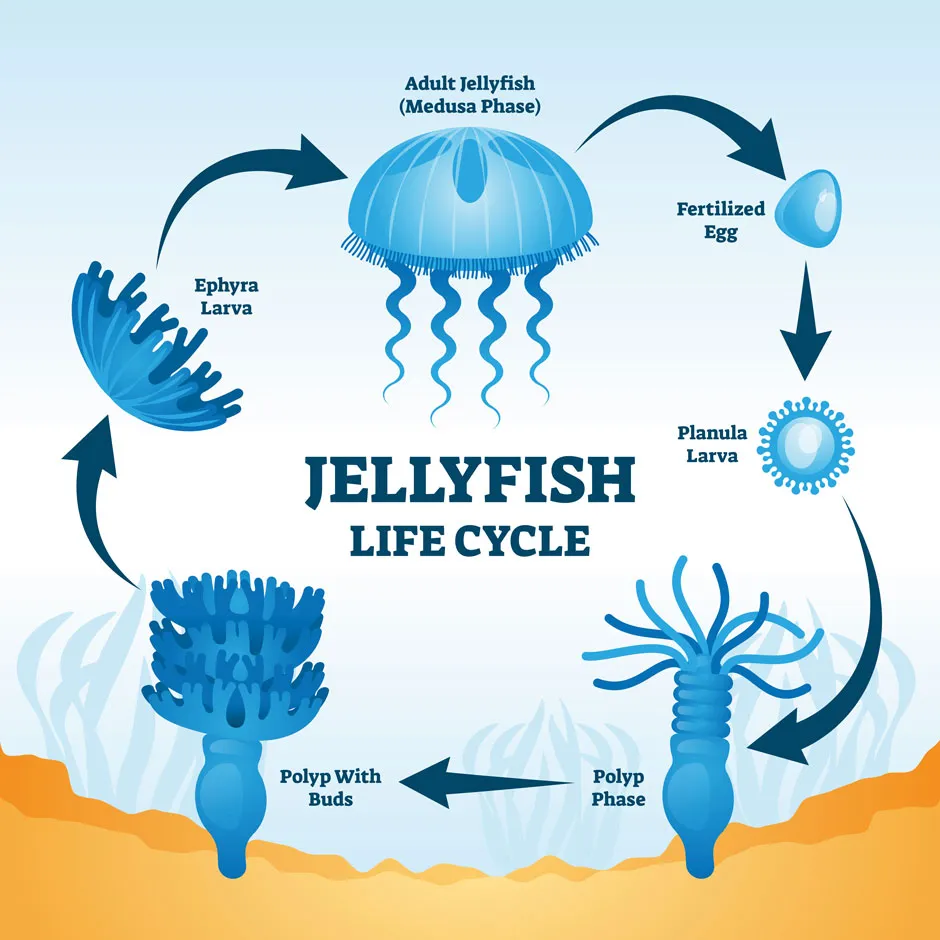The lifespan of a Greenland shark: up to 500 years. The giant barrel sponge: over 2,000 years. But the longest-living animal on planet Earth? The immortal jellyfish, a creature that can seemingly escape from death altogether.
Despite only being only three millimetres in diameter on average, adult versions of these tiny invertebrates have a huge party trick: they can roll back their biological clock when injured or on the verge of starvation. This means, in theory, they could live forever.
But how exactly does the immortal jellyfish (Turritopsis dohrnii) activate their Doctor Who-style powers of regeneration? And could humans harness their abilities to eradicate ageing completely? We dive into the science below.
How long does the immortal jellyfish live?
Potentially forever. Which gets more impressive considering these creatures have been floating through the oceans long before the dinosaurs went extinct (66 million years ago) – it's biologically possible for a single immortal jellyfish to have been alive for this entire time.
However, while this is technically feasible, it's by no means provable. That’s because these jellyfish have only been studied sporadically since the early 1980s, meaning experts have only a few decades’ worth of data.
There’s also another factor to consider. While an immortal jellyfish can age in reverse, it can also be easily killed by predators including various fish, sharks, turtles and even other jellyfish. This is why the immortal jellyfish is unlikely to overpopulate the Earth anytime soon.
How does the immortal jellyfish live forever?
To understand how the immortal jellyfish is able to hack its lifecycle, you first have to dive into how a normal jellyfish ages. Don’t worry, it’s fairly simple. Albeit very very strange.

Normally, a mere mortal jellyfish passes through five stages of life:
- Fertilised egg: an adult jellyfish (known as a medusa) will spawn eggs and sperm into the water, with these two types of cells joining up to create a fertilised egg.
- Planula: the fertilised egg grows into a small larva called a planula. It looks something like a microscopic worm and can swim about freely.
- Polyp: The planula will swim down to find a solid surface (such as a seabed), where it will develop a digestive system and is able to feed itself. When conditions such as water temperature suit it, the polyp will reproduce asexually, cloning itself to create a small colony.
- Ephyra: after forming a new set of muscles and nerves, a section of a polyp (either the original polyp or clone) becomes an ephyra, an organism that can swim independently, grow and feed.
- Medusa: this is a fully-grown adult jellyfish, which can reproduce sexually with another jellyfish (usually dying shortly afterwards).
However, if the grim reaper comes knocking, the immortal jellyfish turns this cycle on its head. If starved, injured or in waters too cold or hot, an adult Turritopsis dohrnii drops to the ocean floor and transforms into a tiny blob of tissue (known as a cyst) and becomes a polyp once again.
It can effectively go back and forwards between the medusa and polyp stage in its lifecycle, almost the biological equivalent of Christopher Nolan’s Tenet.
Read more about ageing:
- Cryonics: Could you live forever?
- Do plants die of old age?
- Feeling old? DNA mutations might be causing you to age quicker
How can this happen? Magic? Stem cells? Close. It's an ability powered by a process known as transdifferentiation.
“This is basically when a fully formed specialised adult cell can become another type of specialised adult cell. It’s how a cell can adapt,” explains Dr Maria Pia Miglietta, associate professor at Texas A&M University at Galveston and head of The Real Immortal Jellyfish research project.
“In the cyst, adult cells can become something that’s needed for the polyp and then, crucially, integrate back into the organism. In just two to three days, the medusa can metamorphose back into a polyp.”
The exact mechanism behind transdifferentiation is still a mystery to scientists. However, as Miglietta explains, the answer will likely be found in the jellyfish's genes.
“It most certainly has something to do with the DNA,” she says. “It’s the DNA that programmes a cell – certain genes being ‘turned on’ or 'off' will determine what sort of cell it is.
“At the moment, we want to understand what kind of genes are turned on in the cyst. Because we think that those are the genes involved in regeneration and the ability of escaping death.”
Could humans become immortal like a jellyfish?
After reading about how jellyfish seem to have achieved eternal life, you’re probably asking one major question: how can I get me some of that? Unfortunately, while the immortal jellyfish can go full Benjamin Button at will, humans are a long way off mastering this level of transdifferentiation.
“We’re far away from any kind of real-world application,” says Miglietta.
“But we hope that studying what happens in these jellyfish can tell us how their genes change cells – and how these changed cells integrate with others. This is the base of understanding cellular regeneration and tissue regeneration.”
“A lot of why we age is still very mysterious. But by looking at this very simple animal with this very simple system, we can follow some genes and see how they behave.”
Read more about the science of ageing:
- The race to stop ageing: 10 breakthroughs that will help us grow old healthily
- Why does time speed up when you get older?
- Epigenetic clock can predict the human brain’s biological age
Where do immortal jellyfish live?
Experts aren’t exactly sure where immortal jellyfish originated from, but today they’re mostly found in tropical regions all around the globe – and that’s all thanks to humans.
As Miglietta’s research suggests, the creatures have been dispersed throughout the world after getting caught ballast water (the water some ships add in hull walls to steady the craft).
“We studied jellyfish in the Pacific, Panama, the Atlantic, Japan, Italy, Brazil and California. And, in the genes that I was looking at, they were all identical. If the jellyfish were spreading naturally, these genes would have accumulated differences in different locations. Identical genes, however, indicate a very recent human intervention.
“Then these jellyfish were found in ballast water, suggesting how they travel. It’s an effect I call a ‘silent invasion'.”

Although it may be easy to get hold of one in tropical areas, we should warn you now: immortal jellyfish make crummy pets.
True, leaving one without grub for a few days won’t be as horrifying as that time your cousin forgot to feed their goldfish for a month (RIP). However, chuck it in a tank and this jellyfish is likely to spend more time metamorphosising (and reverse metamorphosising) than actually floating around.
“They’re incredibly sensitive, from the water temperature, to their plankton and fish egg diet,” says Miglietta. “The real paradox is they’re actually really hard to keep alive!”
About our expert Dr Maria Pia Miglietta
Dr Maria Pia Miglietta is an associate professor at Texas A&M University at Galveston and head of the Miglietta Lab, which focuses on evolution, genetics, and ecology of jellyfish. She is also head of The Real Immortal Jellyfish research project and teaches summer courses on the biology of Cnidaria at the Smithsonian Tropical Research Institute in Panama.
Read more about ageing: